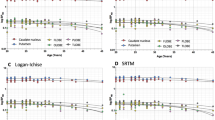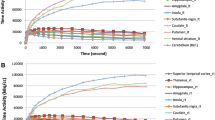Abstract
Positron emission tomography (PET) was used to determine regional brain glucose metabolism in schizophrenic patients (n=17) before and during neuroleptic treatment. The patients had not been treated with neuroleptics for at least 3 weeks before the first study. All suffered from acute psychotic symptoms and were hospitalized to obtain neuroleptic treatment. After determination of regional brain metabolism without neuroleptic treatment, 11 patients were treated with sulpiride (800 mg/day) and 6 patients were treated with chlorpromazine (400 mg/day) over 5–6 weeks before the second PET investigation. The control group consisted of seven healthy male volunteers, also investigated twice 5 weeks apart. The PET investigation was made with the subject in a resting state. The tracer was uniformly labelled 11C-glucose. The metabolism was determined bilaterally in 15 brain regions cortical, as well as central regions. Metabolic rates differed among the groups. The sulpiride group had lower metabolic rates than the controls and the schizophrenic patients later treated with chlorpromazine. The sulpiride group, in which absolute metabolic rates were determined, were clinically more autistic and chronic than the chlorpromazine group. It was proposed that these facts could explain the lower metabolic rates in the sulpiride group. A significant change in metabolism in relation to drug treatment was only found in one brain region. The selective D2-receptor antagonist sulpiride increased the metabolic rate in the right lentiform nucleus in comparison with the patients treated with chlorpromazine and the controls. Likewise, relative metabolic rates were increased only in the right lentiform nucleus. Negative correlations between intensity of clinical symptoms and metabolism indicated that emotional tone and drive were related to brain metabolism. No correlations were found between drug concentrations and metabolism or clinical symptoms.
Similar content being viewed by others
References
Alfredsson G, Wode-Helgodt B, Sedvall G (1976) A mass fragmentographic method for the determination of chlorpromazine and two of its active metabolites in human plasma and CSF. Psychopharmacology 48:123–131.
Alfredsson G, Sedvall G, Wiesel F-A (1979) Quantitative analysis of sulpiride in body fluids by high performance liquid chromatography with fluorescence detection. J Chromatogr 164:187–193.
Alfredsson G, Bjerkenstedt L, Edman G, Härnryd C, Oxenstierna G, Sedvall G, Wiesel F-A (1984) Relationships between drug concentrations in serum and CSF, clinical effects and monoaminergic variables in schizophrenic patients treated with sulpiride or chlorpromazine. Acta Psychiatr Scand [Suppl 1] 69:49–74.
Alfredsson G, Härnryd C, Wiesel F-A (1985) Effects of sulpiride and chlorpromazine on autistic and positive psychotic symptoms in schizophrenic patients — relationship to drug concentrations. Psychopharmacology 85:8–13.
Åsberg M, Montgomery S, Perris C, Schalling D, Sedvall G (1978) CPRS — the psychopathological rating scale. Acta Psychiatr Scand [Suppl] 271:5–27.
Bergström M, Boethius J, Eriksson L, Greitz T, Ribbe T, Widén L (1981) Head fixation device for reproducible position alignment in transmission CT and positron emission tomography. J Comput Assist Tomogr 5:136–141.
Bjerkenstedt L, Härnryd C, Grimm V, Gullberg B, Sedvall G (1978) A double-blind comparison of melperone and thiothixene in psychotic women using a new rating scale, the CPRS. Arch Psychiatr Nervenkr 226:157–172.
Blomqvist G (1984) On the construction of functional maps in positron emission tomography. J Cereb Blood Flow Metab 4:629–632.
Blomqvist G, Bergström K, Bergström M, Ehrin E, Eriksson L, Garmelius B, Lindberg B, Lilja A, Litton J-E, Lundmark L, Lundqvist H, Malmborg P, Moström U, Nielsson L, Stone-Elander S, Widén L (1985) Models for 11C-glucose. In: Greitz T, Ingvar D, Widén L (eds) Metabolism of the human brain studied with positron emission tomography. Raven Press, New York, pp 185–194.
Brooks RA, Di Chiro G, Zukerberg BW, Bairamian D, Larson SM (1987) Test-retest studies of cerebral glucose metabolism using fluorine-18 deoxyglucose: validation of method. J Nucl Med 28:53–59.
Buchsbaum MS, Wu JC, DeLisi LE, Holcomb HH, Hazlett E, Cooper-Langston K, Kessler R (1987) Positron emission tomography studies of basal ganglia and somatosensory cortex neuroleptic drug effects: differences between normal controls and schizophrenic patients. Biol Psychiatry 22:479–494.
Carlsson A (1978) Antipsychotic drugs, neurotransmitters and schizophrenia. Am J Psychiatry 135:164–173.
DeLisi LE, Holcomb HH, Cohen RM, Pickar D, Carpenter W, Morihisa JM, King AC, Kessler R, Buchsbaum M (1985) Positron emission tomography in schizophrenic patients with and without neuroleptic medication. J Cereb Blood Flow Metab 5:201–206.
Ehrin E, Stone-Elander S, Nilsson JLG, Bergström M, Blomqvist G, Brismar T, Eriksson L, Greitz T, Jansson PE, Litton J-E, Malmborg P, af Ugglas M, Widén L (1983) 11C-labelled glucose and its utilization in positron emission tomography. J Nucl Med 24:326–331.
Farde L, Pauli S, Hall H, Stone-Elander S, Eriksson L, Halldin C, Högberg T, Nilsson T, Sjögren I (1988a) Stereoselectivity of 11C-raclopride binding — a search for extrastriatal D2-dopamine receptors in man by PET. Psychopharmacology 94:471–478.
Farde L, Wiesel F-A, Halldin C, Sedvall G (1988b) Central D2-dopamine receptor occupaney in schizophrenic patients treated with antipsychotic drugs. Arch Gen Psychiatry 45:71–78.
Gur RE, Resnick SM, Alavi A, Gur RC, Caroff S, Dann R, Silver FL, Saykin AJ, Chawluk JB, Kushner M, Reivich M (1987a) Regional brain function in schizophrenia. Arch Gen Psychiatry 44:119–125.
Gur RE, Resnick SM, Gur RC, Alavi A, Caroff S, Kushner M, Reivich M (1987b) Regional brain function in schizophrenia. Arch Gen Psychiatry 44:126–129.
Litton J-E, Bergström M, Eriksson L, Bohm C, Blomqvist G, Kesselberg M (1984) Performance study of the PC-384 positron camera system for emission tomography of the brain. J Comput Assist Tomogr 8:74–87.
McCulloch J, Savaki HE, Sokoloff L (1982) Distribution of effects of haloperidol on energy metabolism in the rat brain. Brain Res 243:81–90.
Montgomery SA, Åsberg M (1979) A new depression scale designed to be sensitive to change. Br J Psychiatry 134:382–389.
Palacios JM, Wiederhold K-H (1984) Dopamine D2 receptor agents, but not dopamine D1, modify brain glucose metabolism. Brain Res 327:390–394.
Pernkopf E (1963) Atlas der topographischen und angewandten Anatomie des Menschen. Erster Band: Kopf und Hals. 106. Urban und Schwarzenberg, Munich
Peroutka SJ, Snyder SH (1980) Relationship of neuroleptic drug effects at brain dopamine, serotonin, adrenergic and histamine receptors to clinical potency. Am J Psychiatry 137:1518–1522.
Pizzolato G, Soncrant TT, Rapoport SI (1984) Haloperidol and cerebral metabolism in the conscious rat: relation to pharmacokinetics. J Neurochem 43:631–638.
Pizzolato G, Soncrant TT, Larson DM, Rapoport SI (1985) Reduced metabolic response of the rat brain to haloperidol after chronic treatment. Brain Res 337:1–9.
Pizzolato G, Soncrant TT, Larson DM, Rapoport SI (1987) Stimulatory effect of the D2 antagonist sulpiride on glucose utilization in dopaminergic regions of rat brain. J Neurochem 49:631–638.
Reivich M, Alavi A, Wolf A, Fowler J, Russel J, Arnett C, MacGregor RR, Shiue CY, Atkins H, Dann R, Greenberg JH (1985) Glucose metabolic rate kinetic model parameter determination in humans: the lumped constants and rate constants for (18F)fluorodeoxyglucose and (11C)deoxyglucose. J Cereb Blood Flow Metab 5:179–192.
Selemon LD, Goldman-Rakic PS (1985) Longitudinal topography and interdigita of corticostriatal projections in the rhesus monkey. J Neurosci 5:776–794.
Sheppard G, Gruzelier J, Machanda R, Hirsch SR (1983) 15O positron emission tomographic scanning in predominantly never-treated acute schizophrenic patients. Lancet II:1448–1452.
Simpson EN, Angus JWF (1970) A rating scale for extrapyramidal side-effects. Acta Psychiatr Scand [Suppl] 212
Spitzer RL, Endicott J (1977) Schedule for affective disorders and schizophrenia (SADS), 3rd edn. New York State Psychiatric Institute of Biometrics Research, New York
Volkow ND, Brodie JD, Wolf AP, Angrist B, Russell J, Cancro R (1986) Brain metabolism in patients with schizophrenia before and after acute neuroleptic administration. J Neurol Neurosurg Psychiatry 49:1199–1202.
Wiesel F-A, Wik G, Sjögren I, Blomqvist G, Greitz T, Stone-Elander S (1987) Regional brain glucose metabolism in drug free schizophrenic patients and clinical correlates. Acta Psychiatr Scand 76:628–641.
Winer BJ (1962) Statistical principles in experimental design. McGraw-Hill, New York
Wolkin A, Jaeger J, Brodie JD, Wolf AP, Fowler J, Rotrosen J, Gomez-Mont F, Cancro R (1985) Persistence of cerebral metabolic abnormalities in chronic schizophrenia as determined by positron emission tomography. Am J Psychiatry 142:564–571.
Author information
Authors and Affiliations
Rights and permissions
About this article
Cite this article
Wik, G., Wiesel, F.A., Sjögren, I. et al. Effects of sulpiride and chlorpromazine on regional cerebral glucose metabolism in schizophrenic patients as determined by positron emission tomography. Psychopharmacology 97, 309–318 (1989). https://doi.org/10.1007/BF00439443
Received:
Accepted:
Issue Date:
DOI: https://doi.org/10.1007/BF00439443




